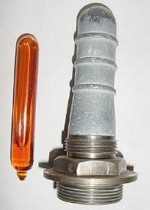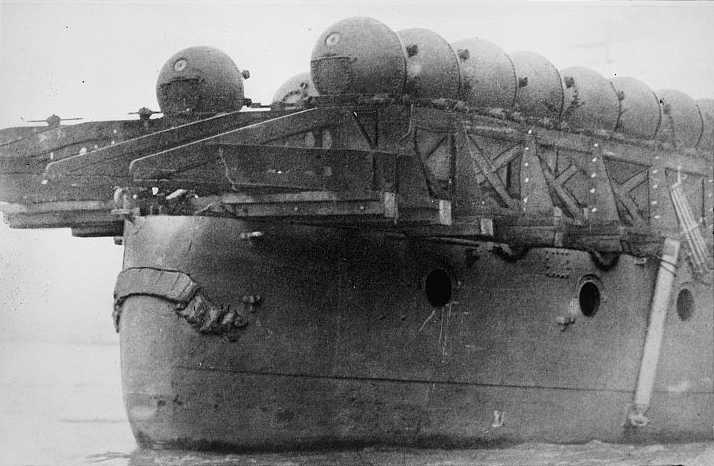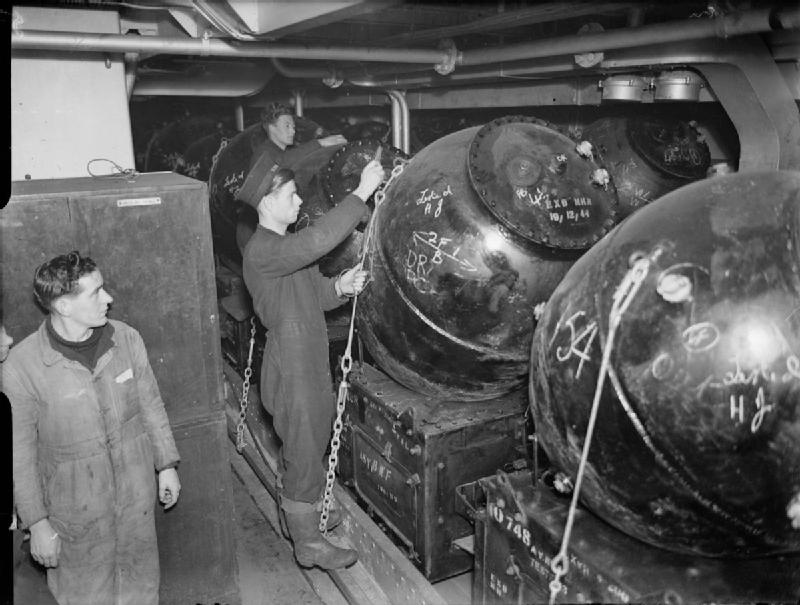| Early History
The Royal Navy made many important inventions relating to mines during the 19th century, but took little serious interest in producing them prior to World War I. Notable was Sir Charles Pasley who in 1839 destroyed the wreck of the Royal George using an underwater charge fired by a remotely controlled electric current, probably the first underwater explosion triggered by electricity. By 1870, the Royal Navy had developed a controlled mine system to be used as a defense for a temporary base. Two types were chosen, one to fired directly from shore and the other to be fired by an inertial trigger with power again supplied by the shore base. Only a few of these were manufactured. By the mid-1870s, experimental work at HMS Vernon, the Torpedo School at Portsmouth, had developed what was called an "electromechanical" mine which used a mechanical or inertia type contact maker, with power supplied from a battery within the mine case. This was apparently the first mine that had an electric battery within the mine itself. Another important invention developed at HMS Vernon was the automatic depth-fixing anchor. All previous moored mines used a fixed-length anchor cable which had to be cut according to the depth desired. The automatic anchor allowed the mine to be placed at the desired depth by simply adjusting the mechanism. Although both inventions had obvious advantages, neither was adopted by the Royal Navy for either their own mines or in mines procured from other nations. By 1894, the Admiralty decided to abandon mining with the exception of a few of the 1873 type kept for experimental and training purposes. In 1900 the Commander-in-Chief of the Mediterranean specifically requested an automatic mine design and some desultory work was undertaken at HMS Vernon. However, in 1903 the design was abandoned. The Russo-Japanese War renewed interest in mines again and in 1906 the "Navy Spherical Mine" was developed (see below). This was the standard mine at the start of World War I, when it was found to be unreliable. Nomenclature Until after the end of World War II most British mines had both a "type" letter and a Mark number. Between about 1918 and 1930 horned contact mines were designated as either "Type H" for those mines using Hertz (acid) horns or "Type T" for Trigger (switch) mines. Moored mines designed after the early 1920s generally had only Mark numbers, but this was not always the case. From that period onwards until after the end of World War II there were the following designations in general use: Mark numbers only - Moored contact, snagline, acoustic and antenna minesWhere "Y" represents the various mark numbers. In addition, there were also "R" mines, intended for use in rivers, "L" mines that were shore controlled and an "O" mine that oscillated from bottom to surface. These were all apparently scrapped shortly after the war ended. Sometime in the 1950s these designations were merged into a single Mark series. Unfortunately, Mark numbers were then reused, causing some confusion. Triggering or Fuzes Contact mines with Hertz Horns were common in designs from World War I to about 1922. Each horn contained acid. Contact with the horn broke open the acid container which energized a battery and exploded the mine. British contact mines were considered unreliable until a German one was captured and duplicated. In the 1920s a variation was developed that replaced the acid horns with switch triggers that activated when a ship hit a horn. By definition, horned mines were short ranged weapons and fields needed to be densely packed in order to be effective against shipping.
Hertz Horn
Late in World War I the British developed a magnetic trigger for ground mines. This was not very successful and little post-war work was done in this area for over a decade. Not until 1936 was a new development order placed for a magnetic trigger for moored mines. A small production order was placed in July 1939 with some 200 being delivered by April 1940. These used a coil-rod (CR) which was fired by an increase in the rate of change of magnetism in the horizontal portion of the field around the trigger. Various delay mechanism were employed to ensure that the ship was close to the mine before firing, not always successfully. Antenna mines using underwater electric potential (UEP) were developed during World War II, apparently with USA help. An acoustic trigger was developed with USA help in the summer of 1942 and first used that fall. Combined acoustic/magnetic triggers were developed the following year and first employed in April 1943. A magnetic/pressure trigger was developed late in the war but it did not see service. British Aerospace developed a microprocessor sensor and processing unit (SAP) in the 1980s that used magnetic and pressure sensors as inputs. This design analyzes acoustic frequencies in three bands intended to cover sonar, engines and propeller noises so as to provide a high degree of target identification. The mines can thus be programmed prior to launch to fire for specific kinds of targets. Explosives Owing to shortages of TNT and RDX (cyclonite) most World War II mines had had 50/50 ammonium nitrate and TNT (amatol) warheads. This was a low quality explosive but was later improved by the addition of about 20% aluminum to produce minol. During the modernization program of the 1980s it was discovered that many of the TNT and RDX fillings of the World War II-era mines had crystallized, causing at least two mines to explode prematurely. Effectiveness during World War I At the beginning of the "Great War" the British had about 4,000 of their unreliable "Navy Spherical Mine" on hand and had tried out a few other types developed by other nations. Sometime soon after the start of the war, the British procured 7,500 Russian mines left at Port Arthur at the end of the Russo-Japanese War. Britain attempted a variety of mine and physical barriers across the Dover Straits, the North Channel and the Adriatic Sea with a total of 128,000 mines being laid. Most of these fields were of relatively limited value, with the exception of the Irish Sea Barrage, which sank 10 U-boats. Minefields laid in enemy waters were more effective. British mines sank a total of 150 enemy war vessels and naval auxiliaries including some 35 U-boats. Worldwide, British mines are reckoned to have sunk a total of 1,047 enemy vessels and damaged a further 541. A total of 48 German submarines were sunk by all Allied mines in World War I. British contact mines of this era suffered from a variety of faults, especially when compared to the German equivalents and to the USA "K" type mines. As noted above, a magnetic ground mine was developed and deployed in August of 1918, but this was too late to be of significant use and was not very successful. Captain Taprell Dorling, commander of a destroyer minelayer during World War I, states in his book "Swept Channels" that in 1917 the Royal Navy had 20,000 mines in stock but "only 1,500 were fit for laying." Effectiveness during World War II During World War II the RAF Home Command laid 48,158 mines during the entire war in enemy waters and these sank 545 merchant ships of 591,143 tons gross and 217 assorted warships of 147,264 tons displacement. Over 20,000 additional mines were laid by surface ships and submarines. The success of these additional mines is not broken out, but "Naval Weapons of World War Two" claims that British mines in total sank 1,050 Axis warships and merchant ships and damaged a further 540. As opposed to the successes achieved via offensive mining, it appears that the British greatly overrated the effectiveness of mines as defensive weapons during World War II. Some 170,000 mines were laid in protective fields by surface ships, the majority in the Iceland and Faeroes passages. This massive effort resulted in exactly one U-boat (U-647) being sunk and had no appreciable effect on the number of U-boats engaged in anti-commerce operations. This might have been forecasted by a study of the 1918 Orkney to Norway mine barrier (also known as the North Sea Mine Barrage) which was an expensive failure. In some ways, these defensive fields restricted the Royal Navy more than the Kriegsmarine. For example, although the German small battleships Gneisenau and Scharnhorst were able to traverse the Dover Straits in 1942, the first British capital ship to do so was HMS Warspite, which passed that way only after the Normandy invasion in June 1944. |


